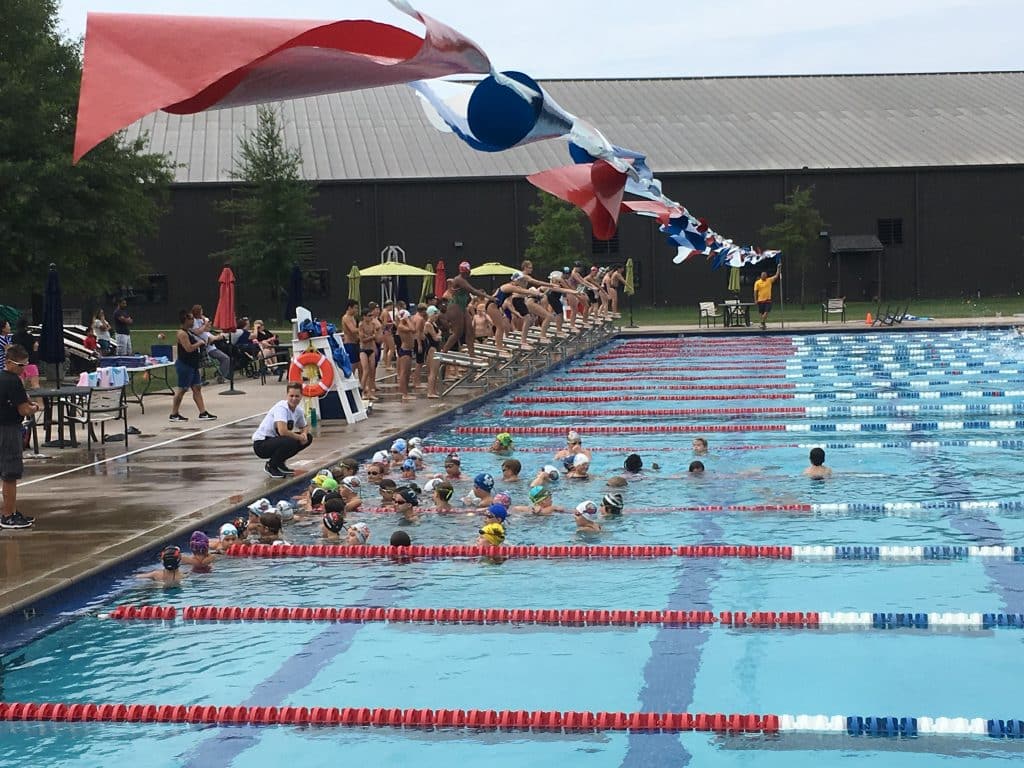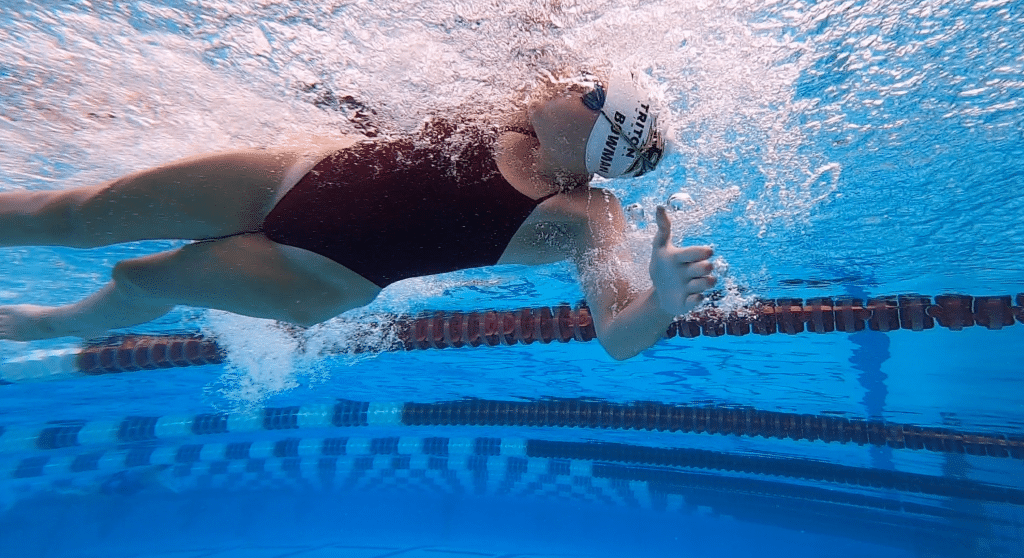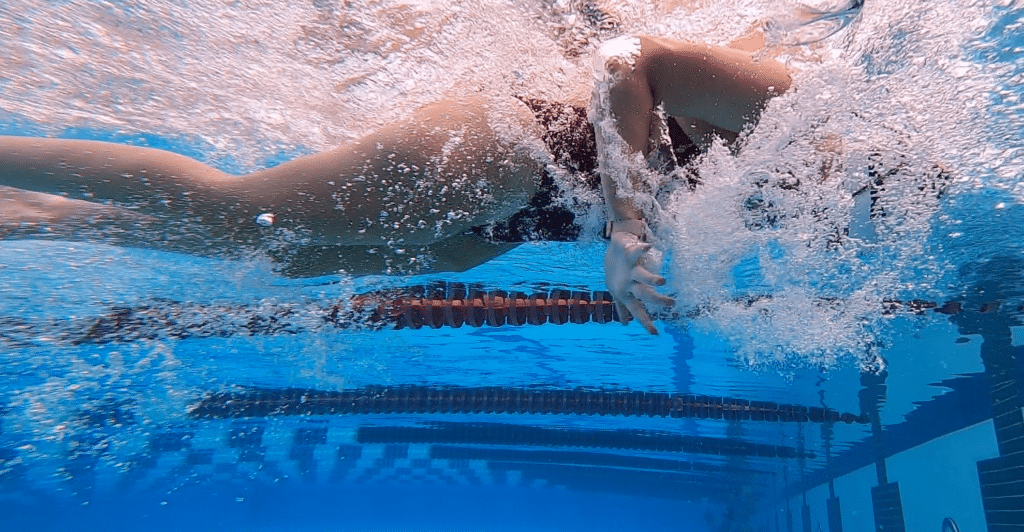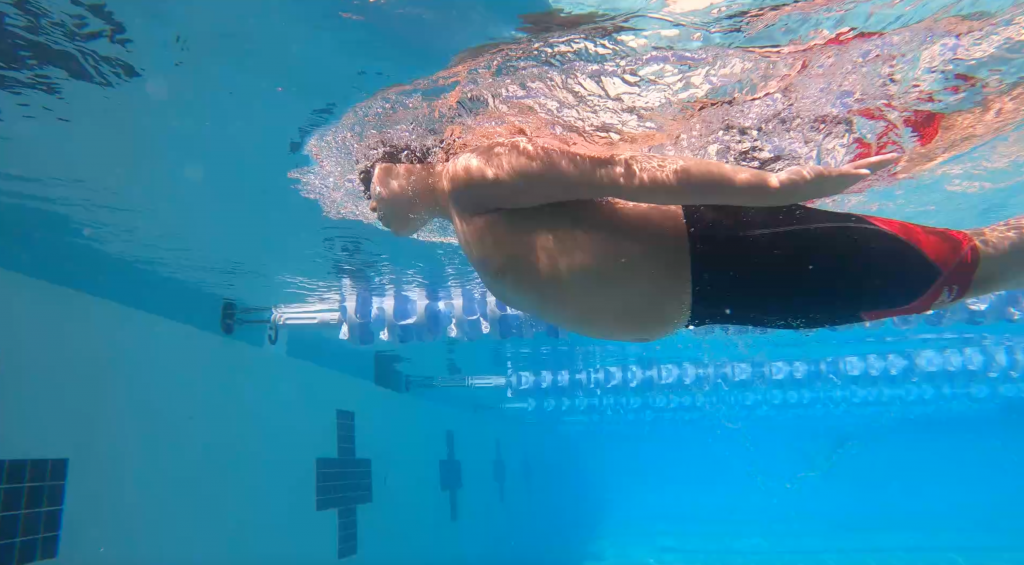Welcome back to our series on Backstroke Flipturns! This will be the start of a new multi-series on Backstroke Flipturns. In today’s blog, we are going to discuss some history on the Backstroke Flipturn and how to best setup & execute this turn!
Let’s get started!
In 1991, the rulebook changed for Backstroke in many ways. World Aquatics (FINA) implemented the restriction of the underwater dolphin kick to 15m, along with allowing the Backstroke Flipturn. This was the first time swimmers could flip at the wall without a hand touch. 1992 was the first Olympic games that were able to see this turn performed on the world’s stage (see below):
Current Rules for Backstroke Flipturns:
SW 6.4 When executing the turn there must be a touch of the wall with some part of the swimmer’s
body. During the turn the shoulders may be turned over the vertical to the breast after which an
immediate continuous single arm pull or immediate continuous simultaneous double arm pull may be
used to initiate the turn. The swimmer must have returned to the position on the back upon leaving
the wall.
So essentially swimmers are allowed to flip past vertical (or perpendicular to the water’s surface) to get to their stomachs to initiate their turn, but how do you do that? Let’s figure it out!
Steps of a Backstroke Flipturn:
1.) You have to KNOW Your Stroke Count!

I always tell my swimmers to find what their normal count is and practice turns with a standard deviation of 1 stroke to account for any mishaps that may happen during a race.
Also, the flags are there for a reason. If the pool is setup as 25 yard pool, the flags will be 5 yards away from the wall. If the pool is setup 50m or 25m, the flags will be 5 meters away from the wall. It’s important that swimmers USE these flags to help them find what their ‘regular’ stroke count.
Obviously stroke count numbers can change depending on their tempo, which is why I always say practice a (+)(-) 1 scenario to account for these potential issues. Also, most swimmers prefer a certain arm to be their final stroke that rolls them from their back to their stomach, so it’s really important that they know which arm that passes the flags too. So if you have a stroke count of 5 and you like rolling over to your stomach using your RIGHT arm being your final ‘stroke’, you better be passing the flags with your LEFT arm to execute this turn correctly.
A lot of gearing up for a Backstroke Flipturn requires swimmers to think about executing the turn WAY before they actually do and that starts with setting up with the correct stroke 5 yds/m away from the wall to hit the wall well!
2.) Get Comfortable with TWO Freestyle Pulls
Wait what? Yep, you heard that right. The FASTEST way to perform a Backstroke Flipturn includes the FINAL two strokes mimicking TWO FREESTYLE PULLS. The first I ever heard this was as ASCA Conference out in Napa, California where Olympic Coach, Dave Durden, dissected what he has done with Ryan Murphy and Jacob Pebley (two American Olympic Backstrokers)!
Why are the Freestyle Pulls Key?
Because they are heck of a lot faster than not grabbing onto any water on the second to last pull (see below):
The biggest difference between the upper video and the bottom and where is the body is in relation to the second to final arm stroke. So if you’re rolling to the left side, it’d be your left arm as the second stroke and the right side would be the right arm. If swimmers can roll to their stomach fast enough, they can mimic two FULL Freestyle Pulls prior to the turn which produce way more force than the side pull as seen below:

The rules do state a swimmer can take a continuous single arm pull or immediate continuous simultaneous double arm pull, so getting two full Freestyle Pulls are totally legal.
One of the common issues I see with swimmers trying to learn this though is actually finishing both their strokes before they initiate the somersault. I’ve nicknamed this term a T-Rex Turn, which is when a swimmer is too close to the wall so they stop their final pull short to accommodate not running into the wall. This issue backs up again the importance of knowing your stroke count, so you can perfectly carry your speed into and out of the turn. A great depiction of a T-Rex Turn is below:

I often get my swimmers out of the water to explain these type of technical pieces: T-Rex and the Final Two Freestyle Pulls. I find it easier to work with them on land to discuss where their body is relation to those final two strokes. Recently, I ran a swim camp at the University of Alabama and worked on the Final Two Freestyle Pulls. Here’s a little preview of what that looked like:
3.) Flip like it’s A Freestyle Flipturn
After you finish the two Freestyle Pulls, swimmers will be on their stomach with their hands at their side.

This position is NO different than a regular Freestyle Flipturn, so the goal here is to plant on the wall well – in a baby squat position and get a really nice/straight push-off. Below you’ll find a really good side by side video showing a Freestyle Flipturn – versus – a Backstroke Flipturn. You will see after a swimmer rolls to their stomach with both hands at their side (shown in the picture above), the movements following this are the same between a Freestyle Flipturn and a Backstroke Flipturn besides the push-off angle.
I always tell my swimmers you go where your fingertips point for your push-off, so if they don’t point straight to the other wall – you may end up going down or up. Depending on your confidence in your dolphin kicks, you may want to spend more or less time underwater – but that is extremely swimmer dependent. I always air on pointing the fingertips down a little bit, since swimmers have a tendency to surface much more quickly on their back than their stomach. Again though, it’s swimmer dependent.
Conclusion:
To have a great Backstroke Flipturn, a swimmer must be confident in their stroke count so they can finish however many FULL strokes they desire. Working on their body position in relation to the last TWO STROKES is key and separates good from GREAT Backstrokers!
After you nail the approach into the wall, getting off the wall is fairly simple due to the Backstroke Flipturn and the Freestyle Flipturn being very similar in nature.
Stay tuned for next week where we discuss the importance of nose clips for Backstrokers and get into the weeds on perform a Dolphin Kick to initiate a somersault!
Until Next Time,
Abbie Fish

3 Responses
Excellent Excellent Excellent
“The biggest difference between the upper video and the bottom … So if you’re rolling to the left side, it’d be your left arm as the second stroke and the right side would be the right arm.” Questions: in the video, which swimmer’s turn is better and why? Bottom guy? Also – I’m confused by the statement above – if I’m rolling to my right side, isn’t my LEFT arm the second stroke? Isn’t my right arm the first stroke?
Love your instructions and videos, Ms. Fish!!
What I mean is what is your second to last arm stroke, so your right side would be your right arm and then your left arm crosses over to finish your hands at your side. The top video is better because of where his body is during that whole transitional process!